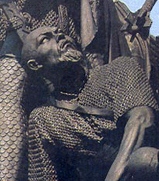The Great Troubles[10][11][d] (Church Slavonic: Великая замятня, romanized: Velikaya zamyatnya, as found in Rus' chronicles[3][e]), also known as the Golden Horde Dynastic War,[14] was a war of succession in the Golden Horde from 1359 to 1381.[14]
This era, which followed shortly after the Black Death had ravaged the cities of the Golden Horde, was characterised by two decades of near anarchy.[15] A long series of short-reigning khans deposed and killed each other, only to suffer the same fate next. Mamai emerged as the most powerful Mongol warlord, frequently employing Rus' principalities such as Tver and Ryazan as his allies.[3] Because he was not a Chingisid (descendant of Genghis Khan), Mamai had no legitimate claim to the throne, and instead used Chingisid puppet-khans to exercise political control.[16]
The Rus' principalities and neighbouring states frequently changed their allegiancies at this time, joining forces with or against various Mongol factions and with or against each other, in tactical efforts to exploit rapidly shifting situations.[8] The Grand Duchy of Lithuania as well as Horde vassals such as Tver and Muscovy were opportunistic in profiting from the internecine warfare that weakened Mongol-Tatar control in the region.[17] Algirdas defeated Mamai's forces at the Battle of Blue Waters and thereby conquered the Principality of Kiev, while Dmitry Donskoy successfully united most Rus' princes against Mamai at the 1380 Battle of Kulikovo, solidifying Muscovite pre-eminence amongst them.[18] However, Tokhtamysh's lightning rise to power in the late 1370s, his definitive victory over Mamai (1381) and subsequent sack of Moscow (1382) confirmed the Rus' principalities' vassalage to the Golden Horde.[19]
- ^ a b c d Martin 2004, p. 208.
- ^ a b c d Halperin 1987, p. 72–3.
- ^ a b c d Halperin 1987, p. 73.
- ^ a b Seleznëv 2009, p. 204.
- ^ a b c Halperin 1987, p. 73–5.
- ^ Halperin 2016, p. 10.
- ^ Halperin 1987, p. 57, 73–75.
- ^ a b Halperin 1987, p. 107.
- ^ a b Halperin 1987, p. 73–75.
- ^ Halperin 1987, p. 73, 100.
- ^ Martin 2004, p. xxi, 195, 207, 209, 215.
- ^ Halperin 2016, p. 8.
- ^ a b Sorogin 2022, p. 36.
- ^ a b Kohn 2013, p. 587.
- ^ Halperin 1987, p. 45.
- ^ Halperin 1987, p. 119.
- ^ Halperin 1987, p. 74.
- ^ Halperin 1987, p. 75, 107.
- ^ Halperin 1987, p. 73–75, 107.
Cite error: There are <ref group=lower-alpha> tags or {{efn}} templates on this page, but the references will not show without a {{reflist|group=lower-alpha}} template or {{notelist}} template (see the help page).
© MMXXIII Rich X Search. We shall prevail. All rights reserved. Rich X Search

